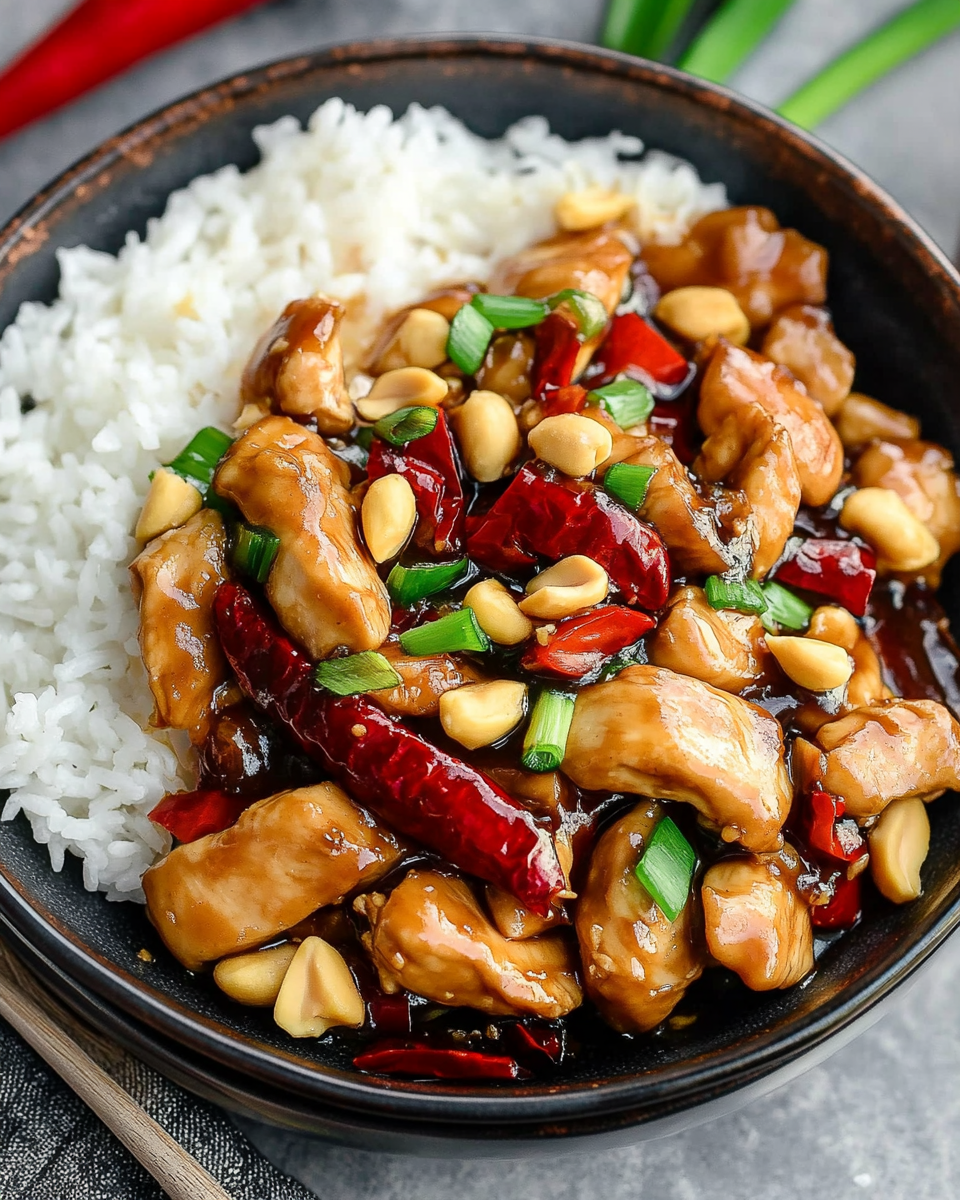Kung Pao Chicken is a classic Sichuan dish known for its bold flavors and delightful textures. Tender pieces of chicken are stir-fried with aromatic garlic and ginger, then tossed in a savory-sweet sauce made with soy sauce, rice vinegar, and Shaoxing wine. The addition of crispy peanuts and spicy dried chilies adds crunch and heat, making each bite a satisfying experience.
This dish is not only delicious but also versatile. You can adjust the level of spiciness by varying the amount of dried chilies used, and the sauce can be customized to suit your taste preferences. Serve it over steamed white rice for a complete meal that’s sure to impress your family and friends.
Full Recipe:
Ingredients:
-
500g boneless, skinless chicken breast, cut into bite-sized pieces
-
1 tablespoon soy sauce
-
1 tablespoon Shaoxing wine (or dry sherry)
-
1 teaspoon cornstarch
-
3 tablespoons soy sauce
-
1 tablespoon dark soy sauce
-
1 tablespoon rice vinegar
-
1 tablespoon Shaoxing wine (or dry sherry)
-
1 tablespoon sugar
-
1 teaspoon cornstarch
-
2 tablespoons water
-
2 tablespoons vegetable oil
-
10-12 dried red chilies
-
1 tablespoon Sichuan peppercorns
-
2 cloves garlic, minced
-
1-inch piece fresh ginger, minced
-
1/2 cup unsalted roasted peanuts
-
2-3 green onions, cut into 1-inch pieces
-
1 red bell pepper, diced (optional)
Directions:
-
In a medium bowl, combine 1 tablespoon soy sauce, 1 tablespoon Shaoxing wine, and 1 teaspoon cornstarch. Add the chicken pieces and mix well to coat. Let the chicken marinate for at least 20 minutes.
-
In a small bowl, mix together 3 tablespoons soy sauce, 1 tablespoon dark soy sauce, 1 tablespoon rice vinegar, 1 tablespoon Shaoxing wine, 1 tablespoon sugar, 1 teaspoon cornstarch, and 2 tablespoons water. Stir until the sugar and cornstarch are fully dissolved. Set aside.
-
Heat the vegetable oil in a wok or large skillet over medium-high heat. Add the dried red chilies and Sichuan peppercorns. Stir-fry for about 30 seconds, or until the chilies darken slightly and become fragrant. Be careful not to burn them.
-
Add the marinated chicken to the wok. Stir-fry for about 4-5 minutes, or until the chicken is browned and cooked through.
-
Add the minced garlic and ginger to the wok. Stir-fry for another 1-2 minutes until fragrant.
-
If using, add the diced red bell pepper and stir-fry for 2-3 minutes until it starts to soften.
-
Pour the prepared sauce into the wok, stirring quickly to coat the chicken and vegetables evenly. The sauce should thicken almost immediately due to the cornstarch.
-
Add the roasted peanuts and green onions. Stir everything together for another minute until well combined and heated through.
-
Transfer the Kung Pao Chicken to a serving dish. Serve hot with steamed white rice.
Prep Time: 20 minutes | Cooking Time: 10 minutes | Total Time: 30 minutes
Kcal: Approximately 350 kcal per serving | Servings: 4 servings
Kung Pao Chicken is more than just a spicy chicken stir-fry it’s a time-honored dish that carries the bold essence of Sichuan cuisine and the rich heritage of Chinese culinary artistry. From its distinctive blend of fiery dried chilies and tongue-tingling Sichuan peppercorns to its crunchy peanuts and umami-packed sauce, this dish has become a favorite across the globe, making its way into homes, restaurants, and takeout menus alike.
In this article, we’ll delve into the origins of Kung Pao Chicken, explore its unique flavor profile, share expert tips for mastering it at home, discuss its nutritional aspects, suggest perfect pairings, and introduce several delicious variations. Whether you’re a novice cook or a seasoned foodie, this guide will help you understand and appreciate Kung Pao Chicken on a deeper level.
The Origins of Kung Pao Chicken
Kung Pao Chicken (宫保鸡丁, Gōng Bǎo Jī Dīng) originated in the Sichuan province of southwestern China, known for its bold, spicy, and often numbing dishes. The name “Kung Pao” is said to be derived from Ding Baozhen, a Qing Dynasty official whose title included “Gong Bao,” or “Palace Guardian.” As legend has it, this dish was created or popularized in his honor due to his love of spicy stir-fried chicken with peanuts.
Over time, Kung Pao Chicken evolved, particularly outside of China. Westernized versions of the dish often include more sugar, less spice, and additional vegetables like bell peppers or zucchini. However, authentic Sichuan-style Kung Pao Chicken stays true to its roots, emphasizing spice, umami, and balance.
A Harmony of Flavor and Texture
What sets Kung Pao Chicken apart from other stir-fried dishes is its perfect harmony of flavor and texture. It’s a masterclass in balancing sweet, sour, salty, and spicy notes.
- Heat: The dish uses dried red chilies for a smoky heat and Sichuan peppercorns for a tingling sensation known as málà. This numbing spiciness is characteristic of many dishes from Sichuan cuisine.
- Savory Depth: Soy sauce and dark soy sauce provide a rich umami base, while Shaoxing wine adds depth and a slightly fermented taste that rounds out the dish.
- Sweet and Tangy: A touch of sugar and a splash of rice vinegar give the sauce a subtle sweetness and acidity, helping to balance the heat and salt.
- Crunch and Tenderness: Roasted peanuts add a delightful crunch, contrasting with the tender chicken, while green onions add freshness and color.
Every bite offers a delightful contrast crispy yet tender, spicy yet slightly sweet, familiar yet exciting.
Tips for Cooking Perfect Kung Pao Chicken at Home
Cooking Kung Pao Chicken at home can be incredibly rewarding, but getting it just right requires attention to detail. Here are some expert tips:
1. Marinate the Chicken
Marinating the chicken with soy sauce, Shaoxing wine, and cornstarch for at least 20 minutes before cooking helps tenderize the meat and gives it a velvety texture. This is a classic Chinese cooking technique known as “velveting.”
2. Use High Heat
Kung Pao Chicken is best cooked in a wok or a heavy skillet over high heat. The fast cooking process seals in juices and prevents the chicken from drying out.
3. Prep Ingredients Ahead
Because the cooking process is quick, it’s essential to have all your ingredients prepped and ready to go—mise en place is key. Once you start stir-frying, there’s no time to chop or measure.
4. Balance the Sauce
The sauce should be well-balanced—neither too salty nor too sweet. Adjust the sugar, soy sauce, and vinegar to your taste. If you’re not a fan of too much heat, reduce the number of dried chilies, or remove their seeds before cooking.
5. Don’t Overcook the Peanuts
Add the roasted peanuts towards the end of the cooking process to retain their crunch. Overcooking them can cause them to become soft or bitter.
Healthy or Indulgent? A Look at Nutrition
Kung Pao Chicken can be both flavorful and nutritious if prepared thoughtfully. Here’s how it stacks up:
- Protein-Rich: Chicken breast is a lean source of protein, making this dish great for those looking to increase their protein intake.
- Moderate Fat: Using a minimal amount of oil and avoiding deep-frying makes the dish relatively low in fat, especially if you skip sugary store-bought sauces.
- Low-Carb Friendly: When served without rice or with a low-carb alternative like cauliflower rice, Kung Pao Chicken fits well into low-carb and keto diets.
- Customizable Calories: The calorie content can be adjusted by altering the amount of oil, sugar, or peanuts used. A typical serving has around 350 kcal, making it a balanced main course.
As with any dish, moderation and ingredient quality are key. Homemade versions are always healthier than restaurant or takeout options, which often contain excessive sugar, sodium, and oil.
Variations and Modern Twists
The classic Sichuan Kung Pao Chicken is just the beginning. Many creative spins on this dish have emerged over the years:
1. Vegetarian Kung Pao
Replace chicken with tofu, tempeh, or even cauliflower for a plant-based alternative. Pan-fried tofu cubes can soak up the sauce beautifully while maintaining a pleasing texture.
2. Kung Pao Shrimp or Beef
For a different protein twist, shrimp or thin slices of beef work excellently with the same flavor base. Just be mindful of cooking times—shrimp, in particular, cook much faster.
3. Westernized Versions
American-Chinese restaurants often sweeten the sauce more and add bell peppers, celery, or water chestnuts. While not traditional, these additions bring more texture and color to the dish.
4. Gluten-Free Adaptation
Use tamari or a certified gluten-free soy sauce and double-check your cornstarch and vinegar to ensure they’re gluten-free. Kung Pao Chicken can easily be adapted for gluten-sensitive eaters.
Perfect Pairings for Kung Pao Chicken
To create a full meal around Kung Pao Chicken, consider these complementary dishes:
- Steamed Jasmine or Basmati Rice: The classic choice for soaking up the flavorful sauce.
- Vegetable Fried Rice or Garlic Noodles: Adds complexity and more texture to the meal.
- Stir-Fried Greens: Bok choy, Chinese broccoli, or snow peas add freshness and balance to the spice.
- Soup Starter: A light miso soup or hot and sour soup pairs beautifully.
A simple green tea or chilled jasmine tea can help cleanse the palate between bites and counteract the heat.
Conclusion: Kung Pao Chicken – A Masterpiece of Spice and Balance
Kung Pao Chicken is a dish that truly captures the spirit of Sichuan cuisine bold, flavorful, and exciting. With its roots in Chinese history and its popularity across the globe, it’s a testament to the power of spice, balance, and texture in cooking.
By preparing it at home, you not only get to enjoy a delicious, restaurant-worthy meal but also connect with a rich culinary tradition. Whether you prefer the authentic Sichuan version or a modern twist, Kung Pao Chicken is a dish that never disappoints.
Give it a try in your kitchen, customize it to your liking, and let its bold flavors transform your dinner routine. Your tastebuds and your guests will thank you.






